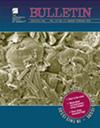青藏高原东南部第四纪火山活动:地幔过渡带停滞的新泰西洋板块记录
IF 3.9
1区 地球科学
Q1 GEOSCIENCES, MULTIDISCIPLINARY
引用次数: 0
摘要
西藏侧向地幔流有助于破解全球板块汇聚区内的物质运动机制。然而,这种地幔流动的前缘尚不清楚。我们对云南西南部(北纬27°以南)第四纪大陆内碱性玄武岩进行了岩石学、地质年代学、矿物学、地球化学和Sr-Nd-Pb同位素研究,以确定青藏高原东南部第四纪碱性玄武岩的岩石成因,特别是青藏高原东南部第四纪碱性玄武岩的岩石成因,并追溯最近的西藏侧向地幔流动。该地区的碱性玄武岩主要是更新世时期喷发的玄武岩和赤玄武岩。它们具有与大洋岛屿玄武岩相似的高度不相容元素和放射性 Sr-Nd-Pb 同位素组成,与部分熔融程度较低的来自天体层地幔的熔体相一致。计算得出的区域碱性玄武岩的岩浆水含量为 1.32 ± 0.48 wt% 至 2.23 ± 0.18 wt%,这相当于其地幔源的水含量为 269 ppm 至 3591 ppm,明显高于正常上地幔的水含量(即 50-250 ppm)。痕量元素定量建模以及 Eu/Eu*、Sr/Sr*、Ce/Pb、(Nb/Th)N-PM 和 (Ta/U)N-PM 等大洋地壳敏感指标的巨大变化表明,上下大洋地壳对岩浆源的贡献各不相同。对岩石学、地球化学和地球物理学证据的系统研究表明,青藏高原东南部第四纪暂时性的小规模火山活动与西藏东南向地幔流动无关,而主要归因于地幔过渡带中停滞的新泰西岩板。我们的研究为协调大陆内碱性玄武岩的地球化学特征提供了一个独特的视角,并突出了碱性玄武岩在追踪西藏近期侧向地幔流动前缘方面的潜在作用。本文章由计算机程序翻译,如有差异,请以英文原文为准。
Quaternary volcanism in southeastern Tibetan Plateau: A record of Neo-Tethyan oceanic slab stagnant in the mantle transition zone
Tibetan lateral mantle flow could help to decipher the material movement mechanisms within global plate convergence zones. However, the front edge of this mantle flow is unclear. We conducted petrological, geochronological, mineralogical, geochemical, and Sr-Nd-Pb isotopic investigations of Quaternary intracontinental alkali basalts from southwestern Yunnan (south of 27°N) to determine the petrogenesis of the Quaternary alkali basalts in the southeastern Tibetan Plateau in particular and to trace the recent Tibetan lateral mantle flow. Alkali basalts in the region are mainly basanite and trachybasalt that erupted during the Pleistocene epoch. They possess highly incompatible elemental and radiogenic Sr-Nd-Pb isotopic compositions similar to those of the oceanic-island basalts, consistent with melts derived from asthenospheric mantle with a low degree of partial melting. Calculated magma water contents of regional alkali basalts range from 1.32 ± 0.48 wt% to 2.23 ± 0.18 wt%, which corresponds to water content of their mantle source comprising 269 ppm to 3591 ppm, which is significantly higher than that of the normal upper mantle (i.e., 50−250 ppm). Quantitative trace-element modeling and dramatic variations in oceanic crust−sensitive indicators such as Eu/Eu*, Sr/Sr*, Ce/Pb, (Nb/Th)N-PM, and (Ta/U)N-PM indicate variable contributions of upper and lower oceanic crust to magma sources. Systematic examinations of petrological, geochemical, and geophysical evidence reveal that the temporary small-volume Quaternary volcanism in the southeastern Tibetan Plateau is unrelated to Tibetan southeastward mantle flow but is primarily attributed to stagnant Neo-Tethyan slab in the mantle transition zone. Our study offers a distinctive perspective for reconciling the geochemical features of intracontinental alkali basalts and highlights the potential role of alkali basalts in tracing the front edge of recent Tibetan lateral mantle flow.
求助全文
通过发布文献求助,成功后即可免费获取论文全文。
去求助
来源期刊

Geological Society of America Bulletin
地学-地球科学综合
CiteScore
9.30
自引率
8.20%
发文量
159
审稿时长
4-8 weeks
期刊介绍:
The GSA Bulletin is the Society''s premier scholarly journal, published continuously since 1890. Its first editor was William John (WJ) McGee, who was responsible for establishing much of its original style and format. Fully refereed, each bimonthly issue includes 16-20 papers focusing on the most definitive, timely, and classic-style research in all earth-science disciplines. The Bulletin welcomes most contributions that are data-rich, mature studies of broad interest (i.e., of interest to more than one sub-discipline of earth science) and of lasting, archival quality. These include (but are not limited to) studies related to tectonics, structural geology, geochemistry, geophysics, hydrogeology, marine geology, paleoclimatology, planetary geology, quaternary geology/geomorphology, sedimentary geology, stratigraphy, and volcanology. The journal is committed to further developing both the scope of its content and its international profile so that it publishes the most current earth science research that will be of wide interest to geoscientists.
 求助内容:
求助内容: 应助结果提醒方式:
应助结果提醒方式:


